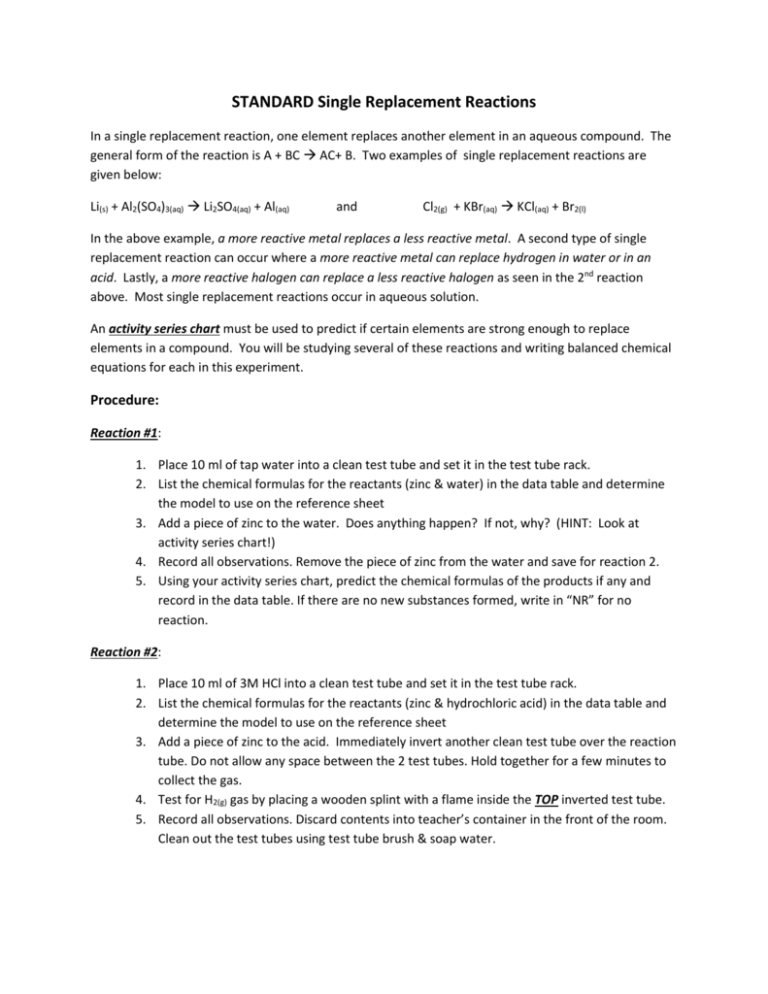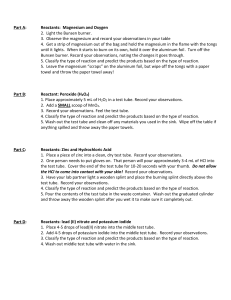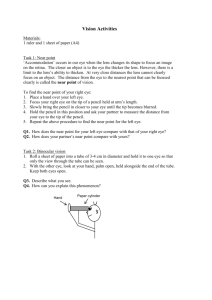Single Replacement Reactions MP lab
advertisement

STANDARD Single Replacement Reactions In a single replacement reaction, one element replaces another element in an aqueous compound. The general form of the reaction is A + BC AC+ B. Two examples of single replacement reactions are given below: Li(s) + Al2(SO4)3(aq) Li2SO4(aq) + Al(aq) and Cl2(g) + KBr(aq) KCl(aq) + Br2(l) In the above example, a more reactive metal replaces a less reactive metal. A second type of single replacement reaction can occur where a more reactive metal can replace hydrogen in water or in an acid. Lastly, a more reactive halogen can replace a less reactive halogen as seen in the 2nd reaction above. Most single replacement reactions occur in aqueous solution. An activity series chart must be used to predict if certain elements are strong enough to replace elements in a compound. You will be studying several of these reactions and writing balanced chemical equations for each in this experiment. Procedure: Reaction #1: 1. Place 10 ml of tap water into a clean test tube and set it in the test tube rack. 2. List the chemical formulas for the reactants (zinc & water) in the data table and determine the model to use on the reference sheet 3. Add a piece of zinc to the water. Does anything happen? If not, why? (HINT: Look at activity series chart!) 4. Record all observations. Remove the piece of zinc from the water and save for reaction 2. 5. Using your activity series chart, predict the chemical formulas of the products if any and record in the data table. If there are no new substances formed, write in “NR” for no reaction. Reaction #2: 1. Place 10 ml of 3M HCl into a clean test tube and set it in the test tube rack. 2. List the chemical formulas for the reactants (zinc & hydrochloric acid) in the data table and determine the model to use on the reference sheet 3. Add a piece of zinc to the acid. Immediately invert another clean test tube over the reaction tube. Do not allow any space between the 2 test tubes. Hold together for a few minutes to collect the gas. 4. Test for H2(g) gas by placing a wooden splint with a flame inside the TOP inverted test tube. 5. Record all observations. Discard contents into teacher’s container in the front of the room. Clean out the test tubes using test tube brush & soap water. 6. Using your activity series chart, predict the chemical formulas of the products if any and record in the data table. If there are no new substances formed, write in “NR” for no reaction. Reaction #3 1. Place 10 ml of tap water into a clean test tube and set it in the test tube rack. 2. List the chemical formulas for the reactants (calcium & water) in the data table and determine the model to use on the reference sheet 3. Add a piece of calcium to the water. Immediately invert another clean test tube over the reaction tube and repeat the test for gas by placing a wooden splint with a flame inside the TOP inverted test tube. 4. You should also check to see if it produces an acid or a base by testing the solution with litmus paper. What color does the litmus paper turn? What does that mean about the solution? 6. Record all observations. Clean out reaction test tube immediately after the reaction is over to prevent it from staining the tube. Discard contents into teacher’s container. Clean out the test tubes using test tube brush & soap water. 7. Using your activity series chart, predict the chemical formulas of the products if any and record in the data table. If there are no new substances formed, write in “NR” for no reaction. Data Table Reaction Model Number Reactant Chemical Formulas Products Chemical Formulas Observations(at least 2 per reaction) #1 #2 #3 Analysis: Use the activity series to write a balanced chemical equation for each reaction: Reaction #2: Reaction #3: Conclusion: Use the introduction paragraph of lab to help answer the questions. 1. Define single replacement reaction. 2. Define activity series chart. 3. Use the activity series to predict the products for each below. Be careful, there could be some NO REACTIONS found and balance the reactions. a. K + HCl(aq) b. Ag + Na2SO4(aq) c. Cl2 + KBr(aq) d. Cu+ H2O ***use copper (I)






